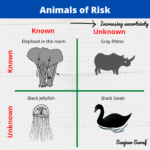In our daily lives we often become immune to risks around us. For example, there are around 40,000 annual fatalities from automobile accidents in the US and yet we do not think twice before getting into their cars. We eat a burger ignoring the risks of heart problems!
Why do we tend to ignore risks that we are frequently exposed to?
To answer this question, I’m going to quote my graduate advisor – Dr. Sam Mannan.
The first time your “low fuel” gauge lights up, you might get worried about running out of gas. However, if you make it to the gas station easily, you may not get as concerned the next time and wait some more time before you stop at a gas station. This relaxation of concern and the time you might wait to stop at a gas station after the gauge comes on might increase as you get more comfortable with the “alarm,” “warning,” or “indicator.” However, if one day you were to run out of gas, it would be hard to argue that you did not have indicators of trouble. Many researchers have called this phenomenon as the “normalization of deviation”, i.e., getting so used to a warning signal that it’s no longer much of a warning. In fact, the phenomenon is such that with time, the increase in deviation accepted by the individual or organization increases in magnitude.
So true! Is this the reason things are Still Going Wrong?





5 Responses
Great post Sanjeev. The normalization of deviation could assist in understanding the numerous repeatable combustible dust related fires that occur in the manufacturing sector. Thees events are precursors to more severe combustible dust explosions that will eventually occur. A majority of stakeholders do not address the root cause of combustible dust related fires. Implementing proactive administrative controls and best engineering practices could reduce the probability and minimize the severity of the next incident.
Why wait for the next warning signal?
John…I agree with your comment and would like to add to it.
There are manufactures who do not know where the risks are so as to mitigate them. If they could recognize the risks and realize the consequence, I’m sure they will act.
A major issue particularly with dust explosions (and reactive chemicals) is that the manufacturers do not recognize the hazard.
The newly released CSB Video, “Combustible Dust: An Insidious Hazard,” is a great start. http://www.csb.gov/videoroom/detail.aspx?VID=30
But not once was combustible dust related fires mentioned. Over 80% of combustible dust incidents last year were fires, precursors to dust explosions. “Houston, …I believe we have normalization of deviation problem here”
Prior to the CBS 60 Minute, segment on combustible dust last year. The producer was looking for a site similiar to Imperial Sugar were a film crew could film as a backdrop, a facility that also was destroyed due to a dust explosion. I suggested a facility that burnt to the ground recently due to a combustible dust related fire.
Not interested. I guess fires aren’t as sexy as explosions. More normalization of deviation. Again great post,Sanjeev. I’m beginning to learn a bit about economic sociology now
” I guess fires aren’t as sexy as explosions.” All too many times this statement is true. It is not until it is too late that people realize that combustible dust fires need to be taken as seriously as dust explosions; especially since combustible dust fires are a precursor to dust explosions.
I have worked on 3 UK top tier COMAH plants and feel that sometimes it is a good practice to take a step back and take a little time out to review what is actually going on in a production unit. So many times simple listening to workers comments regarding an item of equipment or a safe system of work can lead to early capture of a problem that could have led into an incident. A workforce that feels it can be open, honest and has an “eye for small changes” in unit operations often nip looming safety issues in the bud. I suppose we promote a culture of continuous unit risk assessment by honestly listening and assessing, looking for changes, having routine internal / external audits (and acting on their outcomes) and by adopting an attitude that our next incident could be just around the corner. A comment from a friend during an extensively long unit run time without incident sums this culture up… “it’s too quiete… I’m going to check to see what’s wrong.”